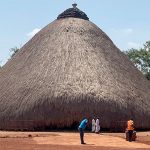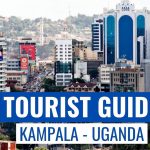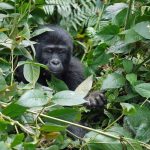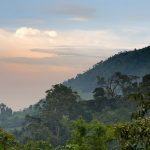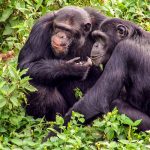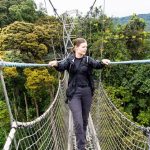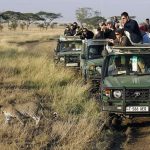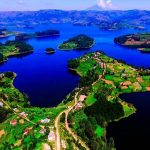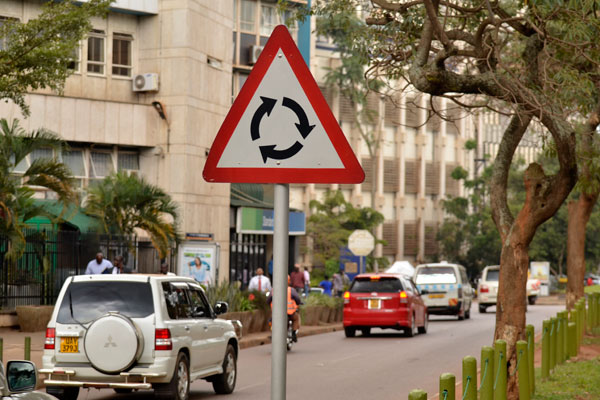The Mountain gorilla is one of the two sub species of the eastern gorilla. One of these populations is in the Virunga Volcanic Mountains of central Africa, within three national parks: in the North West Rwanda; and the Virunga in the eastern democratic Republic of Congo. The other mountain gorillas are found in Uganda’s Bwindi Impenetrable National Park one of the best parks for Uganda safaris. The estimated number of mountain gorillas left in the whole world is about 1000 individuals.
Unlike the lowland gorillas, Mountain gorillas have longer hair and shorter arms and larger than other gorillas and can also climb trees as others. Roughly, about only 880 mountain gorillas can be found alive on planet Earth and about 490 in Uganda, others can be tracked from the forests of the Virunga Mountains – central Africa, Rwanda and Democratic Republic of Congo. Mountain gorillas often like to establish their habitats on green, volcanic slopes and in areas that have seen much human violence from which the gorillas have not escaped untouched. They often feed on tree roots, fruits, tree barks and pulp and other kind of vegetated diet.
They are socially structured in their way of life where they divide themselves into different groupings(troops) of about 30 members (comprising of young males, some females, and their offspring), each being led by a silver back, a dominant elder (most especially older male) uniquely identified by a lining of silver hair adorning the dark fur.
This silverback is responsible for organizing and supervising routine activities like eating, nesting in leaves, and moving about the group’s 2-to-40-square-kilometer home range. Since they are our close cousins, though gorillas are generally calm and non-aggressive, they also neither want to be challenged nor disturbed by other members from other groups. It is a role of the silverback to intimidate the enemies by frightening with impressive shows of physical power through standing upright, making aggressive charges, and pounding his huge chest with continuous powerful barks, hoots and roaring.
After a gestation period of 8 – 9 months, a female gorilla gives birth to a one two-kilogram-helpless-weak-tiny-infant only able to clutch to its mothers’ fur. It starts riding on its mothers’ back from age of 4 to 5 months till the age of 2 to 3 years where it is now able to walk a shorter distance that increases respectively to its age. Just like humans, gorillas at this stage are so playful, they chase themselves, climb trees not forgetting their funniest moment of swinging from tree branches.
In addition, through time gorillas have displayed significant intelligence recognized through continuous adaptation to simple human languages.
Quick Facts
Kingdom: Animalia
Phylum: Chordata
Subphylum: Vertebrata
Class: Mammalia
Order: Primates
Family: Hominidae
Genus, species: Gorilla gorilla.
Size: Up to 6 feet tall
Weight: 300 to 425 pounds
Lifespan: 30-50 years
Habitat: Dense forest, rain forest
Predators: Leopards, crocodiles, humans
Diet: Vegetarian
Lifespan: 53 years in captivity
Gestation: 8 1/2 months
Where to See Gorillas in Uganda
Uganda protects almost half of the world’s remaining population of the mountain gorillas. These great apes are protected in two national parks; Bwindi Impenetrable National Park and Mgahinga Gorilla National Park. If you would love these world’s rarest apes, you only need to plan a gorilla safari to these two national parks.
Where to find them
Mgahinga Gorilla National Park
it is a cultural heritage and part of a larger ecosystem of the Virunga conservation area including two more adjacent parks in both Rwanda and Congo. In Gahinga slopes can be found a swamp filled – crater of about 180m wide and Muhavura the highest peak of mount Mgahinga has a small crater lake about 36m wide at its summit The park can be accessed by road or air transport. Kisoro town at the foot of Mt Muhavura is about 540 km from Kampala and takes about 8 hours via Kabale on an excellent paved road surface. Public transport by bus is available on daily basis. Mgahinga is located 13 km from Kisoro town and can be accessed by public transport. Kisoro town can also be accessed by air by using the runway Airfield at Nyakabande.
Bwindi Impenetrable Forest
Here is a unique wildlife experience, biologically, the Bwindi impenetrable is one of Africa’s richest forests, owing to its great age (over 25000 years) and an altitudinal range that spans 1400 metres. Not only the forest’s star attraction the mountain gorilla, but also much more attractions can be seen here including about 350 birds, 310 butterflies, 200 trees, 51 reptiles, 88 moths, and 120 mammals including several other primates like chimpanzees, black and white colobus, blue monkeys , grey –cheeked mangabey, and L,Hoest’s monkey.
Bwindi has six habituated gorilla groups, which are tracked from four trailheads. Eight permits are available for each group, giving a daily maximum of 48 permits. An addition gorilla group can be tracked on the Virunga volcanoes in the nearby Mgahinga gorilla national park. Tracking the mountain gorillas takes two to eight hours depending on the location of the group.
Bwindi can be reached from QENP in the North (2-3 hours), from Kabale to the South (1-2 hours), or from Kampala via Mbarara (6-8 hours). Roads meet at Butagota 17 km from the Buhoma entrance gate. A 4x4WD car is recommended if you are to travel through Bwindi most especially during the rain season.
Quick Facts About Mountain Gorillas
Diet: They are vegetarian but supplement their diet with a variety of plants like tubers, flowers, fruit, fungus, bed straw, wild celery, stinging nettles and other fruits.
Predators: leopards, humans and Crocodiles to lowland gorillas.
Behavior: The leader of the group/ dominant silverback determines the movement of the group. It mediates conflicts, and also leads them to feeding areas. However, they are highly social, held together by long-term bonds.
Habitat: Gorilla habitats are dense montane forests with rich volcanic soils.
Physical Characteristics: short muzzles, large nostrils; dark small eyes and ears, large jaw muscles and broad, strong teeth. Coarse, ears, hands, and feet.
Mountain gorillas are also descendants of the ancestral monkeys and the apes found in Africa and also the Arabian during the start of the Oligocene. The fossil record provides evidence of the hominoid primates found in east Africa about 18-22 million years ago. Also these fossil records of the area where the mountain gorillas live is also particularly poor and so it’s evolutionary history is not so clear. The mountain gorillas have also been isolated from the eastern lowland gorillas for about 400,000 years.
These have attracted many tourists to come for safaris to Uganda given that gorilla tourism is the main attraction that pulls them to Uganda.
Mountain gorillas have fur thicker and longer than that of the other gorilla species, and also enables them to live in colder temperatures and the gorillas can be identified by nose prints unique to each individual. The males can weigh twice as much as the females. This sub species is on average the second largest species of the primates; only the eastern lowland gorillas, the other subspecies of the eastern gorilla, is larger. The adult males have more pronounced bony crests on the top and black of their skulls, giving their heads a more conical shape. The crests anchor the powerful temporalis muscles, which also attach to the lower jaw; the adult females also have these crests hence less pronounced. And like all the gorillas they feature dark brown eyes framed by a black ring around the iris. These species have greatly attracted many tourists to come for gorilla trekking safaris to Uganda.
NOTE:
Gorilla beringei beringei, (Mountain Gorillas) have half of its population in living in the dense rain forests of Uganda. The largest of the living primates and the last member of the ape family known to science has its habitats in Bwindi Impenetrable National Park with about 380 gorillas, and the remnant population is shared by three Virunga Parks; Mgahinga Gorilla National Park (Uganda), Virunga National Park -Southern Sector (DRC) and the Volcanoes National Park (Rwanda).
Conservation of Mountain Gorillas
Though there are several globally recognizable conservation initiatives established to protect mountain gorillas like Friend a Gorilla, they continue facing major threats from habitat loss and poaching.

